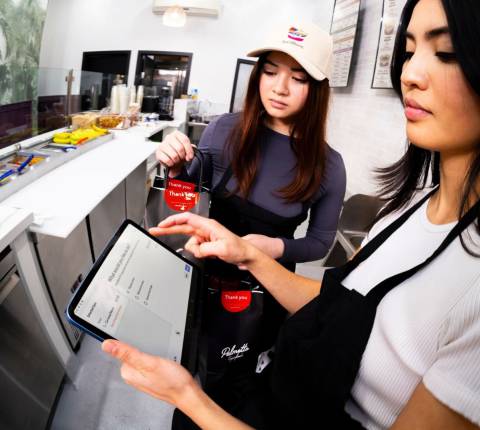Are you a restaurateur interested in keeping up with the latest industry trends, attracting loyal customers, and saving the planet? If so, you’ll be happy to learn that widespread interest in sustainability appears to be here to stay.
With the rise in popularity of local ingredients and sustainable practices, customers are voting with their wallets.
With this in mind, consider reevaluating where your menu ingredients come from and how well your establishment manages waste. For some guidance on how to make your restaurant more sustainable, follow some (or all!) of these restaurant sustainability practices.
1. Begin with some basic research on restaurant sustainability practices
We’re so glad you're open to change. While it may take time to become fully educated on sustainable practices and a little longer to discover how the various methods might work effectively for your business, keep in mind that you don’t need to change everything at once. Start with a single action and think of sustainability as a journey, not an end destination.
2. Train your staff
Once sustainability becomes a key focus for your restaurant, make sure to share relevant information with customer-facing employees, who can then let your customers know about your eco-improvements. Beyond spreading the word verbally, don’t forget to add written information about any sustainable practices to your website, menus, and other advertising outlets to communicate your ongoing commitment to the environment.
3. Think seasonal
One of the first, and possibly most impactful, elements towards sustainability is to offer seasonal menus. These should emphasize fresh, locally sourced items and change frequently based on ingredient availability. Opt for organic, pesticide-free options whenever possible — you may be surprised to see that customers are often willing to cover any resulting increase in cost.
4. Buy local
Contract with nearby farmers and purveyors for local ingredients and supplies. You may want to explore family-owned and small business operations where it can be easier to learn more about their production processes. Better yet, consider growing your own produce in a rooftop or backyard garden. Whenever possible, try to source local wines, beers, and other beverages along with food items. These behaviors will help reduce your restaurant’s carbon footprint by eliminating long-haul or air cargo transportation.
5. Offer a smaller menu
Are you tossing out spoiled ingredients regularly? To help eliminate waste, it may make sense to reduce your overall offerings and focus on a few premiere items. This can also help reduce costs by allowing you to shop fewer ingredients in bulk.
6. Don’t waste food
Although most restaurants don’t intend to over order, unfortunately, a significant amount of food is wasted in the United States. Be mindful of food waste by creating heightened awareness among your employees and encouraging resourcefulness. For example, take advantage of excess ingredients to create specialty stocks and sauces, develop rotating daily specials, or invent an unusual smoothie. You can also donate food items to a shelter. Whatever you do, find ways to avoid tossing food into the garbage.
7. Compost unwanted leftovers
Although smaller portions may help reduce food waste, there will always be customers who don’t clean their plates. Instead of throwing out remnants, put some of these to use by composting. Then, donate the compost to a community garden or, even better, use it to nourish your restaurant’s own garden.
8. Print menus and other paper goods on recycled paper
Since you will likely be printing new menus seasonally, printing disposable menus probably make more sense than higher-cost options. However, give some thought to what you print them on.
9. Consider e-menus and online ordering
You can eliminate individually printed menus or paper orders altogether by implementing a cutting-edge online ordering technology platform. This can be used on-site with kiosks, tablets, or smartphones, or from home when customers place takeout or delivery orders.
10. Avoid single-use plastics
For dine-in customers, offer reusable options like plates, baskets, and glasses. For takeout and delivery orders, explore eco-friendly containers and cups made from plant-based, compostable packaging. Also, be mindful of the health of our oceans by eliminating plastic straws. If a menu item requires a straw, offer a reusable or recyclable alternative.
11. Use cloth napkins
Not only will this help save the trees, but many customers also love the luxuriousness of these elegant alternatives. If cloth isn’t a good option for your brand, hand out paper napkins, or encourage 1-2 napkins per person with signs at self-serve stations, where grabbing an entire stack is a common occurrence.
12. Clean with plant-based, non-toxic products
Of course, don’t neglect healthful cleanliness or properly disinfecting surfaces, but do try to seek earth-friendly cleaning products whenever possible.
13. Recycle packaging
Depending on your vendors, much of your packaging can be returned for future reuse. If not, be sure to provide an adequate bin for all recyclables.
14. Decorate with salvaged materials
Add some charm with reclaimed wood tables, retro tile floors, or unique paraphernalia on the walls. Not everything has to be brand new to create a nice ambiance.
15. Buy energy-efficient appliances
Although the upfront cost is generally higher, these will allow you to reduce costs in the long run while saving water, electricity, and, therefore, the planet.
16. Always keep the main focus on delicious food and excellent customer service
When implementing sustainable practices, don’t compromise on quality in other areas. While today’s customers care more than ever before about protecting the environment, their primary focus when eating out is still to enjoy a tasty meal and the overall dining experience. Anything else is just — well, gravy!





